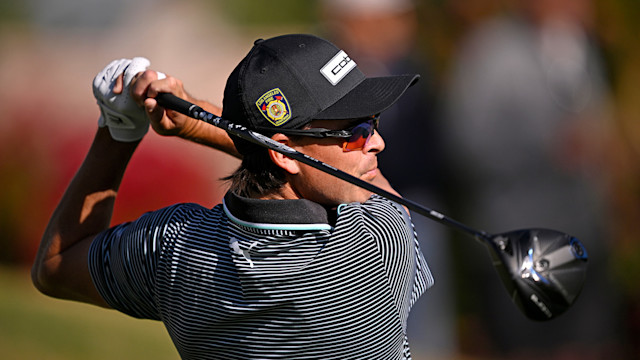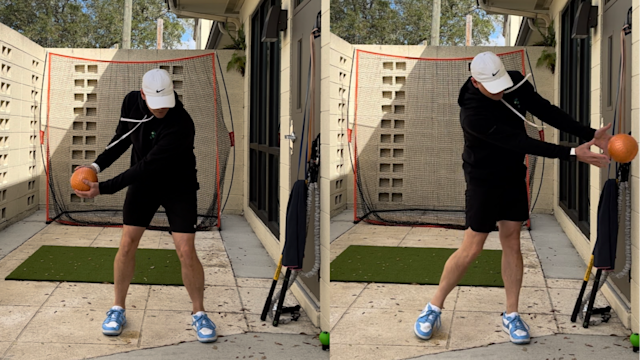quick coaching
Play Better Golf: 3 Proven Tips From the Best Coaches
By Ryan Adams, PGA
Published on

What happens when you combine hundreds of great PGA Coaches from around the world, a lineup of some of the most-well known teachers and subject-matter experts, and two full days of learning?
Well, you'd get the PGA Teaching & Coaching Summit, one of golf's premier coaching events that seems to get better every time.
While there's a lot of the Summit, which took place ahead of the 2025 PGA Show in Orlando, that is geared toward the coaches attending, there was also some extremely valuable instruction nuggets that will help just about any golfer.
Let's dive in.
Pay more attention to your putting

David Orr, PGA, helping out a PGM student with his stroke.
One of the great takeaways of the Summit was the idea of separating out your handicap: one is your tee to green game, and one is your putting.
PGA of America Golf Professional David Orr, who teaches at Pine Needles in North Carolina and is a sought-after putting coach for many tour players, explained that if you want to get better on the greens, you need to treat putting like it's "a different sport."
"A 17 handicapper is not a 17 handicapper in putting," said Orr. "That handicap and their putting performance doesn't usually match up, which means that, if they want to improve, working on their putting twice as much as they think is critical."
Orr and fellow presenter, David Edel, one of the most well-respected putting experts in golf, talked about the idea of getting better not just at putting, but the putting environment.
"That means knowing how to read greens, breaks and different speeds," said Edel. "Because if you know how to read a putt, you at least have a puncher's chance to start the ball on line. A lot of golfers say they struggle with 30-footers or 3-footers. No, what they struggle with is the environment around that putt."
Nerves on the first tee? Try these 3 breathing keys

Andy Matthews explained the importance of breathing during a round.
While a lot of the Summit was about technique and teaching, Andy Matthews from Neuropeak Pro went a little different route.
Matthews, the company's Director of Golf Performance who works with the likes of Keegan Bradley, Jordan Spieth and Madelene Sagström, explained how breathing has such a huge impact on how we play . . . especially in high-stress situations.
Check out his keys on a breathing technique you can implement into your own game:
Key 1: Posture
Posture forms the foundation of effective breathing. Proper alignment creates space for your lungs to
expand fully, allowing oxygen to flow efficiently through your body. Poor posture, on the other hand,
restricts your breathing and increases tension.
expand fully, allowing oxygen to flow efficiently through your body. Poor posture, on the other hand,
restricts your breathing and increases tension.
Try this:
- Sit in a supportive chair, or stand tall, with shoulders relaxed and back. Imagine a string gently
pulling the top of your head toward the sky. - A confident posture not only promotes better breathing but signals readiness and focus to your
brain. - Between golf shots, or in your daily life, use moments of sitting, walking, or standing to reset
your posture and align your body.
Key 2: Muscle Control
The diaphragm is the primary muscle for effective breathing, but under stress, many golfers default to
shallow, chest-based breaths. This inefficient pattern exacerbates stress and undermines performance.
Try this:
shallow, chest-based breaths. This inefficient pattern exacerbates stress and undermines performance.
Try this:
- Place one hand on your chest and one on your belly.Take a deep breath and focus on moving the hand on your belly while keeping the one on your chest still. This is diaphragmatic breathing—a method that engages the right muscles and calms your nervous system.
- While preparing for a challenging shot or a crucial putt, pause and take a slow, controlled breath. This
technique helps balance your nervous system and reset your focus. - Use diaphragmatic breathing during transitions, suchas walking to the next tee or preparing for a tough lie, to reset and maintain composure.
Key 3: Pace
The rhythm of your breathing, commonly referred to as respiration rate, directly influences your stress levels. Rapid, shallow breaths signal danger to your body, keeping it in a fight-or-flight state. By controlling your respiration rate, you can guide your body into a state of balance and focus.
Try this 4-1-4-1 Technique:
1. Inhale through your nose for four seconds.
2. Hold your breath for one second.
3. Exhale slowly through your nose for four seconds.
4. Pause for one second before starting again.
Use this breathing cadence during high-pressure moments, like preparing for a decisive shot. Incorporate it into your pre-round routine or even in your pre-shot routine, as a calming cue for your mind and body.
Use this breathing cadence during high-pressure moments, like preparing for a decisive shot. Incorporate it into your pre-round routine or even in your pre-shot routine, as a calming cue for your mind and body.
The golf swing is a computer, and you need to avoid these two viruses

If there's one name synonymous with the word coaching, "Harmon" is right up there. The legendary PGA of America Golf Professional Claude Harmon Sr. who won the 1948 Masters as a club pro, would be proud that his legacy in coaching is being carried on by his sons, one of whom is Bill Harmon.
Harmon was a long-time caddy to Jay Haas before moving to the Head Professional role at Newport Country Club in Rhode Island, and now he's the Director of Instruction at Toscana Country Club in California. To say Harmon's brain is packed with knowledge would be an understatement but, a lot like his brothers and father, his goal seems to always be making the game simple to understand.
"If you're a beginner golfer, think of your swing like a computer," Harmon said. "The two viruses you have to avoid are, one, trying to lift the ball up and, two, swinging straight back and straight through to get the ball to go straight. A good coach will make sure you avoid both."
Harmon also talked about a foolproof way to cure a slice that he learned from his dad.
"If I took a kid from the jungle and handed him a stick, and he doesn't know anything about golf," Harmon said, "and told him swing it out to the right, what you think he'd do? He wouldn't cut across the ball, he'd swing out to the right. And in order do that, we'd need to get him to have a good grip.
"To combat any slice, start with your grip, because the grip controls the clubface. Once you have that figured, that's when you can start swinging more inside to out to create that draw path."
One last little nugget from Harmon. His dad Claude served as Head Professional at both Winged Foot and Seminole during his career, and at Seminole, he'd play Ben Hogan in a unique money game. They had a hat, and for every time someone missed a fairway, you threw $10 in the hat. The least fairways missed won.
"Dad got pretty good at hitting the fairway," chuckled Harmon. "That was a lesson in course management. Golf is always easier from the fairway."


